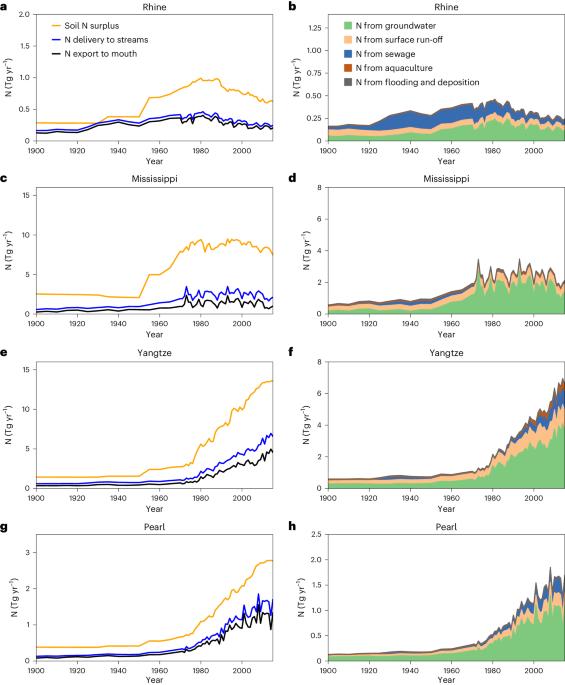Impact of groundwater nitrogen legacy on water quality
IF 25.7
1区 环境科学与生态学
Q1 ENVIRONMENTAL SCIENCES
引用次数: 0
Abstract
The loss of agricultural nitrogen (N) is a leading cause of global eutrophication and freshwater and coastal hypoxia. Despite regulatory efforts, such as the European Union’s Nitrogen Directive, high concentrations of N persist in freshwaters. Excessive N leaching and accumulation in groundwater has created a substantial N reservoir as groundwater travel times are orders-of-magnitude slower than those of surface waters. In this study we reconstructed past and projected future N dynamics in groundwater for four major river basins, the Rhine, Mississippi, Yangtze and Pearl, showcasing different N trajectories. The Rhine and Mississippi river basins have accumulated N since the 1950s and although strategies to reduce excess agricultural N have worked well in the Rhine, groundwater legacy N persists in the Mississippi. The Yangtze and Pearl river basins entered the N accumulation phase in the 1970s and the accumulation is expected to continue until 2050. Policies to reduce N pollution from fertilizers have not halted N accumulation, highlighting the importance of accounting for the N legacy in groundwater. Restoring groundwater N storage to 1970 levels by diminishing N leaching will therefore take longer in the Yangtze and Pearl (>35 years) than in the Rhine (9 years) and Mississippi (15 years). Sustainable watershed management requires long-term strategies that address the impacts of legacy N and promote sustainable agricultural practices aligned with the Sustainable Development Goals to balance agricultural productivity with water conservation. National and international policies have aimed to protect the quality of freshwater by mitigating agricultural nitrogen emissions. However, the nitrogen legacy in groundwater must be accounted for when mitigating the impacts of nitrogen in watersheds.

地下水氮遗留对水质的影响
农业氮(N)的流失是全球富营养化以及淡水和沿海缺氧的主要原因。尽管制定了欧盟氮指令等监管措施,淡水中的氮浓度仍然很高。由于地下水的流动时间比地表水慢几个数量级,因此地下水中过量的氮浸出和积累形成了一个巨大的氮库。在这项研究中,我们重建了莱茵河、密西西比河、长江和珠江四大流域地下水中过去和未来的氮动态,展示了不同的氮轨迹。自 20 世纪 50 年代以来,莱茵河和密西西比河流域一直在积累氮,虽然减少过量农业氮的战略在莱茵河流域取得了良好效果,但在密西西比河流域,地下水遗留氮仍然存在。长江和珠江流域在 20 世纪 70 年代进入氮积累阶段,预计氮积累将持续到 2050 年。减少化肥氮污染的政策并没有阻止氮的积累,这凸显了考虑地下水遗留氮的重要性。因此,与莱茵河(9 年)和密西西比河(15 年)相比,通过减少氮沥滤将地下水中的氮储存量恢复到 1970 年的水平需要更长的时间(35 年)。要实现流域的可持续管理,就必须制定长期战略,解决遗留氮的影响,并推广符合可持续发展目标的可持续农业实践,以平衡农业生产力与水资源保护之间的关系。国家和国际政策旨在通过减少农业氮排放来保护淡水质量。然而,在减轻氮对流域的影响时,必须考虑到地下水中遗留的氮。
本文章由计算机程序翻译,如有差异,请以英文原文为准。
求助全文
约1分钟内获得全文
求助全文
来源期刊

Nature Sustainability
Energy-Renewable Energy, Sustainability and the Environment
CiteScore
41.90
自引率
1.10%
发文量
159
期刊介绍:
Nature Sustainability aims to facilitate cross-disciplinary dialogues and bring together research fields that contribute to understanding how we organize our lives in a finite world and the impacts of our actions.
Nature Sustainability will not only publish fundamental research but also significant investigations into policies and solutions for ensuring human well-being now and in the future.Its ultimate goal is to address the greatest challenges of our time.
 求助内容:
求助内容: 应助结果提醒方式:
应助结果提醒方式:


